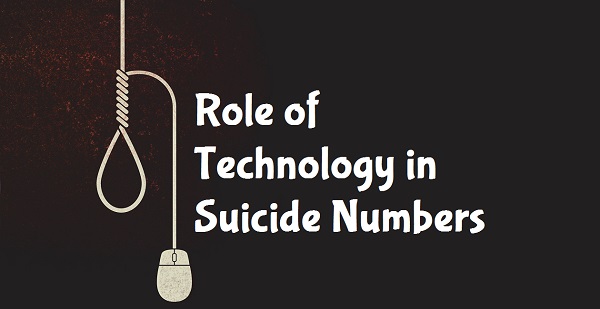Role of Technology in Suicide Numbers- Tamil Nadu Case Study

From Current Affairs Notes for UPSC » Editorials & In-depths » This topic
IAS EXPRESS Vs UPSC Prelims 2024: 85+ questions reflected
How prevalent is suicide in India?
- India witnesses more than 1,00,000 suicide deaths every year. A 2021 Lancet study noted that the country records the highest number of suicide deaths in the world.
- According to the National Crime Records Bureau’s data for 2021:
- There were 1,64,033 suicide deaths. This is a 7.2% increase from 2020 numbers.
- Among the states, the highest number of suicide deaths were reported in Maharashtra (22,207), Tamil Nadu (18,925), Madhya Pradesh (14,965), West Bengal (13,500) and Karnataka (13,056).
- Among the UTs, the highest number of suicides were reported in Delhi, the most populous UT, with 2,840 deaths.
- The cumulative numbers from the 53 megacities alone stood at 25,891 deaths, with the highest contributions from Delhi City (2,760), Chennai (2,699), Bangalore (2,292) and Mumbai (1,436).

How much of a role does technology play in suicide numbers?
- Debates on suicide have often pointed to the growing presence of digital technology as one of the causes of suicide. Technology is repeatedly being blamed for aggravating mental health issues like depression.
- Some of the ways technology is worsening the suicide issue are:
- Cyberbullying
- Social media’s negative impact on self-esteem
- Unhealthy levels of binge-watching
- Unhealthy reliance on virtual communities/ followers for validation, etc.
- While it is true that technology has a role in worsening India’s mental health and suicide situation, it isn’t the core reason.
- For instance, while the link between suicide attempts and cyberbullying can’t be denied, as seen from the a US National Institutes of Health study which found that cyberbullying victims were over 4-times more likely to report having suicidal thoughts and attempting suicides.
- However, similar links exist between suicide attempts and in-person bullying. This implies that technology is only functioning as a medium. Medium of bullying cannot be the sole culprit and it is the bullying itself that needs addressing.
- Hence, sensational and misguided studies on the causes of suicides is a concerning issue in that it robs the focus away from a proper understanding of this concerning social issue and the subsequent development of appropriate solutions.
Tamil Nadu Case Study:
This can be understood from considering the suicide cases in Tamil Nadu.
- The news reports associated a spate of suicides with gaming addiction– particularly online rummy games.
- These reports prompted the state government to issue an ordinance to ban online games played for money, such as poker and rummy.
- However, multiple independent studies, like the Rainbow Project of Rotary, found such associations between suicides and online rummy games to be highly exaggerated. In fact, a Psychology Professor, Sandip Shah, from Gujarat’s Shri Govind Guru University, made a direct representation to the state government on the insufficiency of data correlating suicides and online gaming.
- As seen from the NCRB data, Tamil Nadu has one of the highest shares of suicide deaths in India- accounting for more than 11% of the total cases in the last decade.
What is the real culprit?
- Some of the major causes of suicide noted by the 2021 NCRB report are:
- Career problems
- Sense of isolation
- Abuse
- Violence
- Family issues
- Mental disorders
- Alcoholism
- Financial loss
- Chronic pain, etc.
- Psychiatrists have raised concern about the sensationalization of suicide deaths and its repeated projection in media. Such sensationalization is known to increase suicide risk, especially among the young and the vulnerable who may identify with the situation.
- Werther Phenomenon refers to copycat suicides being triggered by prominent and graphical display and explanation of suicide methods. Some triggers include repeated exhibition of suicide images, in-detail explanation of methods and screaming headlines sensationalizing suicides.
What is the way ahead?
- As technology gains influence over the society, its role is bound to become starker- in both, the best and worst of human experience.
- The government is already taking steps to harness technology’s powers in improving mental health outcomes. Recently, it launched the National Tele-Mental Health Program, Tele MANAS to provide 24/7 free mental health interventions to the citizens, even in the remote and under-served regions.
- However, we need to realize that technology isn’t the problem’s core, nor is it the perfect solution.
- Addressing India’s suicide problem requires sensitivity and holistic policy making.
- Some of the key steps, that could help address bullying- cyber or otherwise, include:
- Awareness campaigns
- Sensitization programs
- Community support
- Counseling services, etc.
- When it comes to the media, the focus should be on following the guidelines on suicide reporting and providing helpline numbers for the viewers.
- If it must, the media could choose to show the sufferings of the victims’ family and friends, rather than the gory details of the suicide itself. However, care must be taken to prevent the disclosure of victim’s identity.
- Instead of top-down policies focusing on just a few high-profile incidents, there is a need for effective approaches that are community-based. Meanwhile, the states could consider harnessing technological advantages for improving their policies’ outcome.
Conclusion:
Suicide deaths continue to remain a significant source of social distress in India, even 2 decades into the 21st century. Technology has a role to play, but its extent must be assessed in an objective manner, in addition to identifying the actual contributing factors to enable the formulation of an appropriate solution.
Practice Question for Mains:
Examine the role of technology in India’s suicide deaths. (250 words)
If you like this post, please share your feedback in the comments section below so that we will upload more posts like this.

